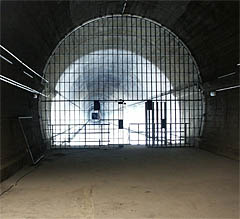
From the atomic bunker for West German officials, there is a museum
 |
A 19-kilometer-long labyrinth of corridors was built between 1960 and 1972 at the site of a railway tunnel that never served its purpose, despite its completion being part of military-strategic plans during both World Wars. During the Second World War, however, it served the Nazis as an underground factory, where prisoners from concentration camps assembled engines for V2 rockets and spare parts for tanks.
It was the Cold War that gave the project a new meaning. "Alternative residence of the constitutional organs of the Federal Republic of Germany", as the original complex and the current museum are officially called, was meant to provide shelter not only for the entire government and the federal president but also for three thousand of their collaborators if necessary.
The project consumed at least 4.78 billion marks (almost 62 billion Czech korunas), making it the largest single investment in the history of West Germany. The complex, codenamed Rose Garden, was hidden by trees and plants in the idyllic vineyard landscape near the town of Bad Neuenahr-Ahrweiler in the state of Rhineland-Palatinate. The bunker itself was located about a hundred meters deep within one hill.
In the event of a nuclear strike, the seat of the West German government in Bonn would likely be the main target, explains Jörg Diester, who wrote a book about the government bunker after studying about 25,000 pages of archival documents. "They would have to get out of Bonn," he says.
It was never needed for such a purpose, and after the Cold War, most of the complex was demolished. The remaining two hundred meters of tunnels now serve as the main part of the exhibition.
Just a short distance from the parking lot created from a former helipad, visitors first encounter the newly built museum with the original protective concrete wall, behind which lies the entrance to the tunnel. "Caution! Life-threatening!" warns the still-present red sign.
However, the most interesting features are hidden inside. The exhibition documents the history of the underground world with the help of objects and photographs. The underground city, nicknamed "Inn at the Last Hour", housed offices and meeting rooms, about 900 sleeping cells, kitchens, canteens, a communication center, workshops, a boiler room, and ventilation shafts. The 25-ton armored doors could close behind the underground city within seconds.
Tourists can still view the showers and toilets. In the medical station, an old dental chair has been preserved, while office equipment on display includes a telephone, several teletypes, and dictaphones.
Thanks to photographs, visitors can get an idea of what a senior politician's bedroom looked like: a narrow bed, one cupboard, maybe a table and a chair. Compared to most others, real luxury; less prominent residents had to settle for bunk beds. "The federal president had a separate room," says Markus Heibel from the Federal Office for Construction.
In the concrete cells, there was, of course, only artificial light. It was easy to lose sense of direction in the underground labyrinth, which is why the walls were marked with numerous numbers. However, the tour for tourists ends after just 200 meters at a barrier, beyond which lies a view into seemingly endless space.
The English translation is powered by AI tool. Switch to Czech to view the original text source.
0 comments
add comment










